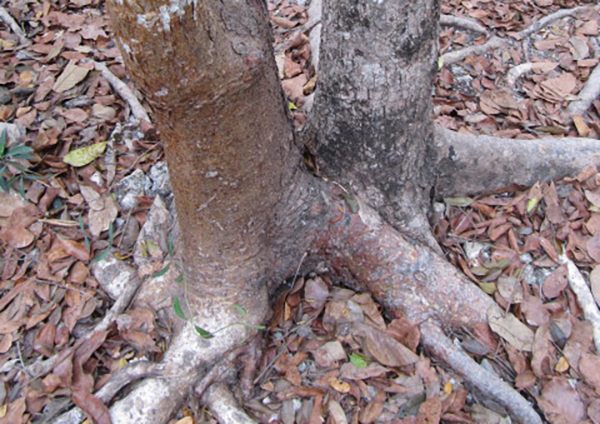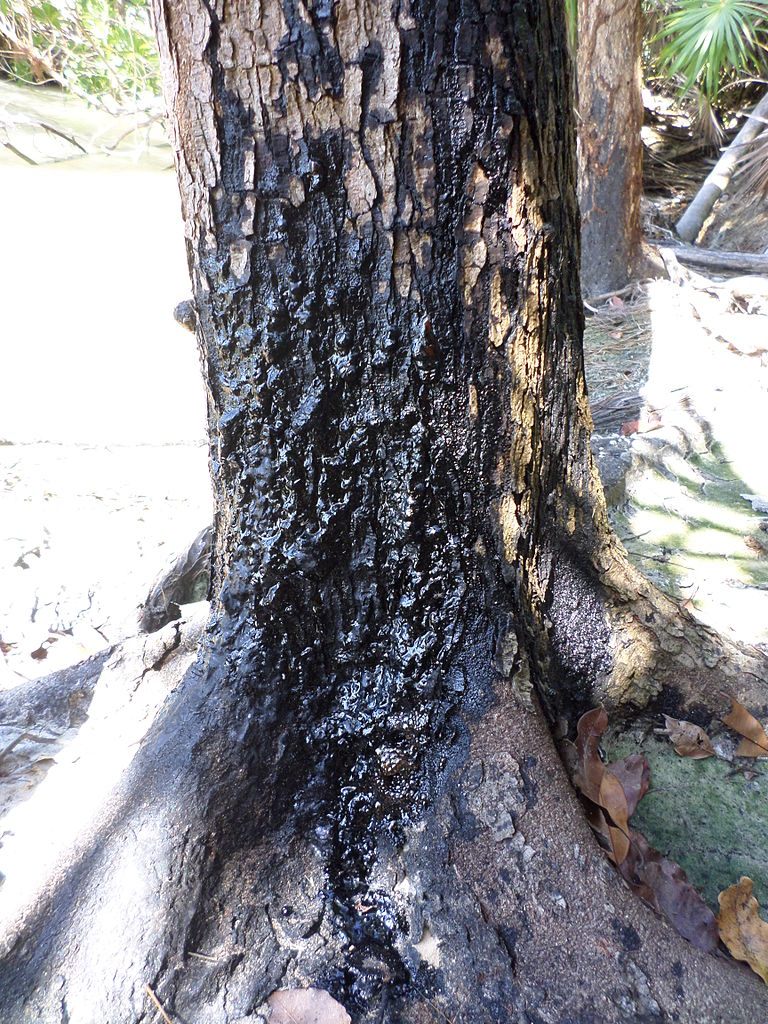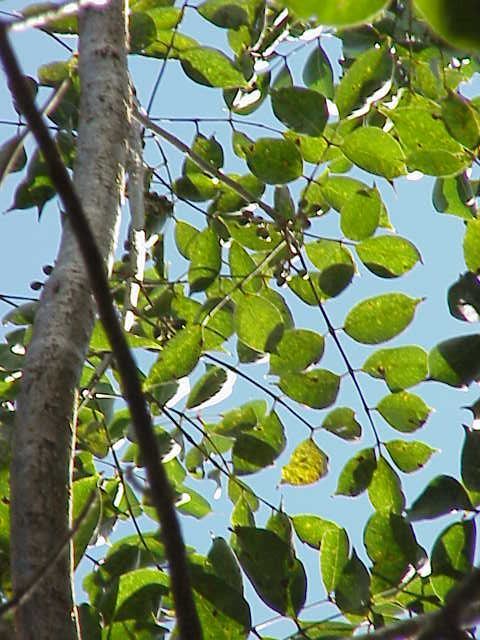The Incredible Coincidence of a Poisonous Tree Growing Next to Its Antidote
These trees, found in Mexico and parts of Central America, are an arborlogical wonder.

Chechem and Chaka trees connected at the roots. (Photo: Leonora (Ellie) Enking/cropped from original/CC BY-SA 2.0)
Explorers take heed: The jungles of Southern Mexico and Central America are ruled by a tangled gang of trees and vines. The vegetation of this region grows thick and quickly, making it almost impossible to navigate without a machete and a compass. Even more surprising, perhaps, is that the greenery itself is a hazard: There are at least 11 species of plants and trees in Central America which are considered poisonous to the touch and can cause severe contact dermatitis, i.e., a horrible burning rash.
There is only one, though, where the poison and the antidote grow side by side.
The offending tree’s official name is Metopium brownei, known locally as chechém or black-sap poisonwood and it’s highly unpleasant. The bark and leaves of Metopium brownei contain a high dose of an oily substance called urushiol, the active chemical agent in poison ivy and many other similarly gifted plants.

Toxic sap from metopium brownei, or chechem. (Photo: Francisco J. Chan Caamal/C BY-SA 3.0)
When this chemical invades your skin it sets off an elaborate, internal alarm system. Langerhan cells, your body’s guard dogs, alert the immune system to the presence of intruders and summon T-cells to deal with the infection. They do this by calling for back-up, releasing signal proteins called cytokines and chemokines which order white blood cells called lymphocytes to assassinate the infected cells. Here’s the problem: The T-cells and lymphocytes also call for back-up creating a chain-reaction which leads to a vicious cycle of attack and alert. It would be like every soldier in the army calling in their very own airstrike, then the pilots calling in more troops who call in more airstrikes, and so on. The blistering rash that follows is a physical symptom of the human body’s natural reaction to this chemical assault. (For those who prefer cartoons to text-books, there is a lovely animated explanation of the body’s reaction here. )
Typical treatment of urushiol-based skin infection in North America is limited to a thorough scrubbing and topical application of calamine lotion. This doesn’t actually treat the painful chemical process taking place below the surface, though, so much as calm the redness and help stop its spread.
Fortunately, the remedy is close. A tree called Bursera simaruba, known by locals as chaka and sometimes called the Gumbo-Limbo tree is a bioactive species which, when processed correctly, acts as an antidote to chechém. The chemistry behind this relationship is complex, with several bioactive chemical compounds in the bark and leaves of bursera working together. Several studies identified chemical constituents including picropolygamain, amyrin and elemicine that are both individually beneficial to the human body and also combine to produce a powerful antioxidant. This is the key to shutting down your body’s reaction to the toxins in chechém. The antioxidants break that painful cycle of alert and attack raging below the skin, essentially calling a cease-fire and allowing the body’s reaction to stop. Active chemical agents also work to alleviate inflammation of the affected area, reducing swelling and itching.

Leaves of bursera simaruba, or chaka. (Photo: Kurt Stueber/CC BY-SA 3.0)
The combination of a tree poison, and antidote, sitting right next to each other is astounding. The trees even look alike! But although the jungle is ripe with bio-diversity, the close proximity of these two trees might not be total coincidence. One theory explaining why chechém and chaka grow close to one another comes from an oral tradition handed down through history by the Yucatec Maya. I first heard it years ago from an old man sitting at a bar in Tulum, Mexico.
He told me the story of two ancient brothers, Kinch and Tizic, young Mayan Lords who fell tragically in love with the same beautiful woman, Nicté-Ha. The brothers were polar opposites; one calm and thoughtful, the other reckless and evil. They fought a furious battle driven by passionate jealousy and in the end the brothers died in each other’s arms, neither attaining the love they so endlessly sought. Their final request of the Gods was to see their beloved Nicté-Ha again so the brothers were reincarnated as chechém and chaka—two trees that share one flower.
The legend is actually an obscure clue to the puzzle of the trees. The answer has to do with the flowers and fruit these trees both produce. It turns out that by “sharing the same flower” (and fruit) these trees end up also sharing various birds that typically eat from both trees. The seeds are then deposited in the same place and often take root less than a meter apart.

A rash from the chechem tree. (Photo: John Michael Peck)
Although the proximity of these bioactive trees remains unique, “sting and relief” relationships are actually quite common in nature. Indigenous people of the world have long stood as pioneers in the trial and error science of jungle-pharmacology. North America has its own remedy for urushiol infections usually caused by poison ivy, an herb called Impatiens capensis or jewelweed. The infamous death-cap mushroom has a recently discovered natural antidote derived from Silybum marianum, a flower common in the Mediterranean.
Some of the most interesting chemical relationships on Earth can be found on the African continent. For example, the Bassa tribe from central Cameroon uses a flowering tree called Strophantus gratus to tip their poison arrows and Alstonia boonei—another tree—as the antidote.
As for the jungles of Central America, they continue to be a source of rare biological discoveries. The old man from that bar in Tulum actually told me something else about chechém which I found quite interesting: He said that if I didn’t believe it could hurt me, it would not.

Blossoms on the Bursera simaruba. (Photo: Bob Peterson/CC BY 2.0)
The idea certainly inspired confidence but unfortunately I proved him wrong a few days later, after slashing my way through a thicket of the stuff while running away from some drunken soldiers. .
If you ever have to learn this lesson the hard way, make sure that you can tell the difference between Bursera simaruba (the antidote) and Metopium brownei (the poison)—the leaves themselves look quite similar. The most reliable way to tell the difference is the bark as chechém has a grey trunk with black sap-streaks while chaka bark is reddish brown and flaky. To achieve the desired effect, boil a large handful of chaka leaves or crushed bark until the water is thick and crimson colored. Apply often until the rash begins to fade and whatever you do, don’t scratch.
















Follow us on Twitter to get the latest on the world's hidden wonders.
Like us on Facebook to get the latest on the world's hidden wonders.
Follow us on Twitter Like us on Facebook